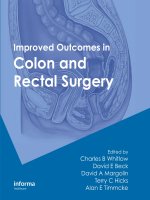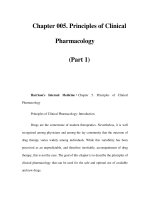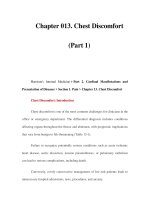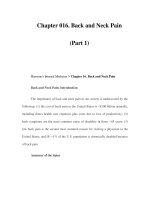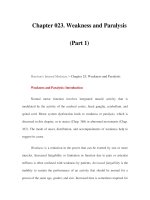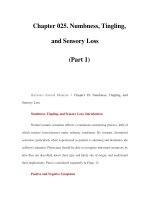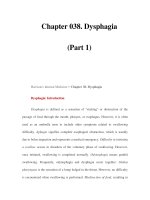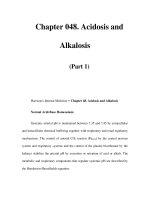MEDICAL STATISTICS - PART 1 pps
Bạn đang xem bản rút gọn của tài liệu. Xem và tải ngay bản đầy đủ của tài liệu tại đây (493.58 KB, 26 trang )
MEDICAL STATISTICS from A to Z
From ‘Abortion rate’ to ‘Zygosity determination’, this accessible introduction to the terminology
of medical statistics describes more than 1500 terms, all clearly explained, illustrated and defined
in non-technical language, without any mathematical formulae! With the majority of terms
revised and updated and the addition of more than 100 brand new definitions, this new edition
will enable medical students to quickly grasp the meaning of any of the statistical terms they
encounter when reading the medical literature. Furthermore, annotated comments are used
judiciously to warn the unwary of some of the common pitfalls that accompany some cherished
biomedical statistical techniques. Wherever possible, the definitions are supplemented with a
reference to further reading, where the reader may gain a deeper insight, so whilst the definitions
are easily disgestible, they also provide a stepping stone to a more sophisticated comprehension.
Statistical terminology can be quite bewildering for clinicians: this guide will be a lifesaver.
Brian Everitt is Editor-in-Chief of Statistical Methods in Medical Research and Professor
Emeritus at King’s College, London.
i
ii
MEDICAL STATISTICS
fromAtoZ
A Guide for Clinicians and Medical Students
Second Edition
B.S. Everitt
Institute of Psychiatry, King’s College, University of London
iii
cambridge university press
Cambridge, New York, Melbourne, Madrid, Cape Town, Singapore, São Paulo
Cambridge University Press
The Edinburgh Building, Cambridge cb2 2ru, UK
First published in print format
isbn-13 978-0-521-86763-4
isbn-13 978-0-521-68718-8
isbn-13 978-0-511-25763-6
© B. Everitt 2006
Every effort has been made in preparing this publication to provide accurate and
up-to-date information which is in accord with accepted standards and practice at the
time of publication. Although case histories are drawn from actual cases, every effort has
been made to disguise the identities of the individuals involved. Nevertheless, the
authors, editors and publishers can make no warranties that the information contained
herein is totally free from error, not least because clinical standards are constantly
changing through research and regulation. The authors, editors and publishers therefore
disclaim all liability for direct or consequential damages resulting from the use of
material contained in this publication. Readers are strongly advised to pay careful
attention to information provided by the manufacturer of any drugs or equipment that
they plan to use.
2006
Informationonthistitle:www.cambrid
g
e.or
g
/9780521867634
This publication is in copyright. Subject to statutory exception and to the provision of
relevant collective licensing agreements, no reproduction of any part may take place
without the written permission of Cambridge University Press.
isbn-10 0-511-25763-5
isbn-10 0-521-86763-0
isbn-10 0-521-68718-7
Cambridge University Press has no responsibility for the persistence or accuracy of urls
for external or third-party internet websites referred to in this publication, and does not
guarantee that any content on such websites is, or will remain, accurate or appropriate.
Published in the United States of America by Cambridge University Press, New York
www.cambridge.org
hardback
p
a
p
erback
p
a
p
erback
eBook (NetLibrary)
eBook (NetLibrary)
hardback
Preface to the second edition
In the second edition of Medical Statistics from A toZIhaveaddedmanynew
definitions and taken the opportunity to correct and clarify a number of entries.
More references are also provided that point readers to more detailed accounts of
topics.
Preface to the first edition
Clinicians, research workers in the health sciences, and even medical students often
encounter terms from medical statistics and related areas in their work, particularly
when reading medical journals and other relevant literature. The aim of this
guide is to provide such people with nontechnical definitions of many such
terms. Consequently, no mathematical nomenclature or formulae are used in the
definitions. Those readers interested in such material will be able to find it in one of
the many standard statistical texts now available and in The Cambridge Dictionary
of Statistics. In addition, readers seeking more information about a particular
topic will hopefully find the references given with the majority of entries of some
help; whenever possible, these involve medical rather than statistical journals, and
introductory statistical texts rather than those that are more advanced. (References
are not given for terms such as mean, variance and critical region for which
further details are easily available in most introductory medical statistics texts.)
Several forms of cross-referencing are used. Terms in
courier new appear
as a separate headword elsewhere in the dictionary, although this procedure is
used in a relatively limited way with headwords defining frequently occurring terms
such as random variable, probability and sample not referred to in this way. Some
entries simply refer readers to another entry. This may indicate that the terms are
synonymous or that the term is discussed more conveniently under another entry. In
the latter case,the term isprinted initalics in themain entry. Entriesarein alphabetical
order using the letter-by-letter rather than the word-by-word convention.
Of the many sources of material I have consulted in the preparation of this book,
I would like to mention two that have been of particular help, namely the
Encyclopedia of Biostatistics and the Dictionary of Epidemiology.
v
REFERENCES
Armitage, P. and Colton, T., 1989, Encyclopedia of Biostatistics, J. Wiley & Sons, Chichester.
Everitt, B. S., 2006, The Cambridge Dictionary of Statistics, 3rd edn, Cambridge University Press,
Cambridge.
Last, J. M., 2001, Dictionary of Epidemiology, 4th edn, Oxford University Press, New York.
vi
A
Abortion rate: The annual number of abortions per 1000 women of reproductive age
(usually defined as age 15–44 years). For example, in the USA in 1970 the rate was
five, in 1980 it was 25 and in 1990 it was 24. [Family Planning Perspectives, 1998, 30,
244–7.]
Abortion ratio: The estimated number of abortions per 1000 live births in a given year.
For example, in the USA in 1970 the ratio was 52, in 1980 it was 359 and in 1990 it
was 344. [Family Planning Perspectives, 1998, 30, 244–7.]
Abscissa: The horizontal (or x-axis) on a graph, or a particular point on that axis.
Absolute cause-specific risk: Synonym for absolute risk.
Absolute deviation: Synonym for average deviation.
Absolute risk: Often used as a synonym for
incidence, although also used occasionally
for
attributable risk,
excess risk or risk difference. Defined
more properly as the probability that a disease-free individual will develop a given
disease over a specified time interval given current age and individual risk factors,
and in the presence of
competing risks. Absolute risk is a probability and
consequently lies between 0 and 1. See also relative risk. [Kleinbaum, D. G.,
Kupper, L. L. and Morgenstern, H., 1982, Epidemiologic Research: Principles and
Quantitative Methods, Lifetime Learning Publications, Belmont.]
Absolute risk reduction: The proportion of untreated people who experience an
adverse event minus the proportion of treated people who experience the event. For
example in a
clinical trial of mammography it was found that out of
129 750 women who were invited to begin having mammograms in the late 1970s
and early 1980s, 511 died of breast cancer over the next 15 years, a death rate of 0.4
percent. In the control group of 117 260 women who were not invited to have
regular mammograms, there were 584 breast cancer deaths over the same period, a
death rate of 0.5 per cent. So the estimated absolute risk reduction is 0.1 per cent.
See also relative risk and number needed to treat. [Sackett, D. L., Richardson,
W. S., Rosenberg, W. and Haynes, R. B., 1997, Evidence Based Medicine: How to
Practice and Teach EBM, Churchill Livingstone, New York.]
Absorbing barrier: See random walk.
Accelerated failure time model: A general model for data consisting of
survival
times
, in which explanatory variables measured on an individual are assumed to
1
act multiplicatively on the timescale, and so affect the rate at which an individual
proceeds along the time axis. Consequently the model can be interpreted in terms
of the speed of progression of a disease. This model which simply regresses the
logarithm of the survival time on the covariates, although used far less often that
Cox's proportional hazards model, might be a useful alternative in
many situations because of this intuitive physical interpretation. [Collett, D., 2003,
Modelling Survival Data in Medical Research, 2nd edn, Chapman and Hall/CRC,
Boca Raton, FL.]
Acceptable quality level: See quality control procedures.
Acceptable risk: The risk for which the benefits of a particular medical procedure are
considered to outweigh the potential hazards. For example, islet transplantation
would help to control the many secondary effects of type 1 diabetes, but what is the
appropriate level of risk to implement this technology responsibly considering the
possible dangers from retroviruses? [Nature, 1998, 391, 326.]
Acceptance region: A term associated with statistical significance tests, which gives the
set of values of a
test statistic for which the null hypothesis is to be
accepted. Suppose, for example, that a
z-test is being used to test the null
hypothesis that the mean blood pressure of men and women is equal against the
alternative hypothesis that the two means are not equal. If the chosen significance
of the test is 0.05, then the acceptance region consists of values of the test statistic z
between −1.96 and 1.96. [Altman, D. G., 1991, Practical Statistics for Medical
Research, Chapman and Hall/CRC, Boca Raton, FL.]
Accident proneness: A personal psychological factor that affects an individual’s
probability of suffering an accident. The concept has been studied statistically
under a number of different assumptions for accidents:
r
pure chance, leading to the
Poisson distribution;
r
true contagion, i.e. the hypothesis that all individuals initially have the same
probability of having an accident, but that this probability changes each time an
accident happens;
r
apparent contagion, i.e. the hypothesis that individuals have constant but
unequal probabilities of having an accident.
The study of accident proneness has been valuable in the development of particular
statistical methodologies, although in the last two decades the concept has, in
general, been out of favour. Attention now appears to have moved more towards
risk evaluation and analysis. [Shaw, L. and Sichel, H. S., 1971, Accident Proneness,
Pergamon Press, Oxford.]
Accrual rate: The rate at which eligible patients are entered into a
clinical trial,
measured as people per unit time. Often disappointingly low, for reasons that may
be both physician and patient related. [Journal of Clinical Oncology, 2001, 19,
3554–61.]
Accuracy: The degree of conformity to some recognized standard value. See also bias.
Accuracy versus precision: An accurate estimate is close to the quantity being
2
estimated. A precise interval estimate is a narrow one, but it may not be accurate
even when quoted to a large number of decimal places.
ACES: Abbreviation for active control equivalence studies.
ACF: Abbreviation for autocorrelation function.
ACORN: Acronym for ‘a classification of residential neighbourhoods’. A system for
classifying households according to demographic, employment and housing
characteristics of their immediate neighbourhood. Derived by applying
cluster
analysis
to 40 variables, including age, class, tenure, dwelling type and car
ownership, used to describe each neighbourhood. [Dorling, D. and Simpson, S.,
1999, Statistics in Society, Arnold, London.]
Acquiescence bias: The
bias produced by respondents in a survey who have the
tendency to give positive answers, such as ‘true’, ‘like’, ‘often’ or ‘yes’ to a question.
At its most extreme, the person responds in this way irrespective of the content of
the question. Thus a person may respond ‘true’ to two statements such as ‘I always
take my medicine on time’ and ‘I often forget to take my pills’. See also
end-aversion bias.[Journal of Intellectual Disability Research, 1995, 39, 331–40.]
Active control equivalence studies (ACES): Studies that aim to demonstrate that an
experimental treatment is equivalent in efficacy to a standard treatment. The
justification for undertaking such studies is that even if the new treatment is no
more effective than the existing treatment in alleviating a particular condition, it
may still be of use for patients who are resistant to, or who simply cannot tolerate,
the standard treatment. So
clinical trials are sometimes undertaken when
the object is simply to show that the new treatment is at least as good as the existing
treatment. [Senn, S., 1997, Statistical Issues in Drug Development,J.Wiley&Sons,
Chichester.]
Active control trials:
Clinical trials in which the new treatment is compared
with some other active agent rather than a placebo. For example, a clinical trial
investigating treatments for asthma might compare the long-acting beta-agonists
salmeterol and formoterol with the shorter-acting beta-agonist salbutomol.
[Senn, S., 1997, Statistical Issues in Drug Development, J. Wiley & Sons,
Chichester.]
Active life expectancy (ALE): Defined for a given age as the expected remaining years
free of disability. In
life expectancy the end point is death. In active life
expectancy the end point is the loss of independence or the need to rely on others
for assistance with daily activities. ALE is a useful index of public health and quality
of life in a population. Interest in recent years has centered on whether current
trends towards longer life expectancy have been accompanied by comparable
increases in active life expectancy. See also disability-free life expectancy. [New
England Journal of Medicine, 1983, 309, 1218–24.]
Activities of daily living scale (ADLS): A scale designed to measure physical
ability/disability that is used in investigations of a variety of chronic disabling
conditions, such as arthritis. The scale is based on scoring responses to questions
3
about mobility, self-care, grooming, etc. See also Barthel index and health
assessment questionnaire.[Journal of the American Medical Association, 1963, 185,
914–19.]
Actuarial statistics: The statistics used by actuaries to evaluate risks, calculate liabilities
and plan the financial course of insurance, pensions, etc. An example is
life
expectancy
for people of various ages, occupations, etc. See also life table.
[Benjamin, B. and Pollard, J. H., 1993, The Analysis of Mortality and Other Actuarial
Statistics, 3rd edn, Institute of Faculty of Actuaries, Oxford.]
Adaptation: A heritable component of the
phenotype that confers an advantage in
survival and reproduction success; the process by which organisms adapt to
environmental conditions. [Sham, P. C., 1998, Statistics in Human Genetics, Arnold,
London.]
Adaptive design: Atypeof
clinical trial in which the treatment a patient
receives depends to some extent on the response to treatment of previous patients
in the study. The aim is to diminish the proportion of patients being given the
‘inferior’ treatment as the trial proceeds. Despite considerable efforts by
statisticians, most clinicians regard the methodology behind such designs to be too
simplistic to be a credible approximation to the realities of clinical research. As a
result, the approach is not used widely in practice. See also play-the-winner rule
and two-armed bandit allocation.[International Statistical Review, 1985, 53, 31–4.]
Addition rule for probabilities: For two mutually exclusive events, i.e. events that
cannot occur together, the probability of either event occurring is the sum of the
two individual probabilities. The rule extends in an obvious way to more than two
mutually exclusive events. See also multiplication rule for probabilities.
Additive effect: A term used when the effect of administering two or more factors
together is the sum of the effects that would be produced by each of the factors in
the absence of the others.
Additive genetic variance: The variance of a characteristic that can be explained by the
additive effects of
genes. [Sham, P. C., 1998, Statistics in Human Genetics, Arnold,
London.]
Add-on trial: A
clinical trial that compares treatments, say A and B,inthe
presence of a standard treatment, say S, the randomized comparisons being
S + A versus S + B. Under certain conditions, B may be a placebo version of A.
Used routinely in AIDS trials. [Statistical Methods in Medical Research, 2002, 11,
1–22.]
Adequate subset: A term used most often in regression analysis for a subset of the
explanatory variables that is thought to be as adequate for predicting the response
variable as the complete set of explanatory variables under consideration. See also
all-subsets regression and selection methods in regression.
Adherence: Synonym for compliance.
Adjectival scales: Scales with adjectival descriptions and discrete or continuous
responses. Two examples are:
4
1. Discrete response (participants may circle one)
How much pain are you suffering today?
Below average Average Above average
2. Continuous response (participants may mark anywhere on the line)
How satisfied are you with your treatment?
Very dissatisfied Dissatisfied Neutral Satisfied Very satisfied
[Streiner, D. L. and Norman, G. R., 1989, Health Measurement Scales, Oxford
University Press, Oxford.]
Adjusted R
2
: The square of the
multiple correlation coefficient
adjusted
for the number of parameters in the model under consideration. [Der, G. and
Everitt, B. S., 2001, A Handbook of Statistical Analysis using SAS, 2nd edn, Chapman
and Hall/CRC, Boca Raton, FL.]
Adjusted treatment means: A term usually applied to the estimates of the treatment
means in an
analysis of covariance after they have been adjusted for the
covariates of interest using the estimated relationship between the covariates and
the response variable. [Fisher, L. D. and Van Belle, G., 1993, Biostatistics,J.Wiley&
Sons, New York.]
Adjusting for baseline: The process of allowing for the effect of baseline characteristics,
particularly a pre-randomization measure of the response variable, on the response
variable, usually in the context of a
clinical trial. A number of methods
might be used, for example the analysis of simple
change scores, the analysis of
percentage change, or, in some cases, the analysis of more complicated variables,
such as 100 × change/baseline. In general, it is preferable to use the adjusted
variable that has least dependence on the baseline measure. In the context of a
longitudinal study in which the correlations between the repeated measures
over time are moderate to large, then using the baseline values as covariates in an
analysis of covariance is known to be more efficient than analysing
change scores. See also baseline balance. [Senn, S., 1997, Statistical Issues in Drug
Development, J. Wiley & Sons, Chichester.]
Adjusting for baseline: Change scores remain popular despite being less powerful than using
analysis of covariance. It is difficult to think why.
ADLS: Abbreviation for activities of daily living scale.
Administrative databases:
Databases derived from information collected routinely
and systematically for purposes of managing a healthcare system. Such data can be
5
used to examine admission procedures and lengths of stay and make comparisons
across hospitals, communities and regions. [Grady, M. L. and Schwartz, H. A.,
1992, Medical Effectiveness Research Data Methods, Department of Health and
Human Services, Rockville, MD.]
Admixture in human populations: The exchange of
genes by breeding between
members of different linguistic and cultural groups, or the sudden infusion of
genes caused by large-scale migration. [Annals of Human Genetics, 1971, 35,
9–17.]
Adoption studies: Studies involving subjects raised by nonbiological parents. Such
studies have played a prominent role in the assessment of genetic variation in
human and animal traits. For example, if the shared environment is influential,
then siblings raised in the same family should be more similar than adopted-away
siblings (siblings reared apart). [Fuller, J. L. and Thompson, W. R., 1978,
Foundations of Behavior Genetics, Mosby, St Louis, MO.]
Adverse event: Any undesirable consequences experienced by a patient during a medical
investigation or study, particularly a
clinical trial. These can range from the
minor, for example constipation, to the far more serious, for example a heart attack.
Aetiological fraction: Synonym for attributable risk.
Age heaping: A term applied occasionally to the collection of data on ages when these are
accurate only to the nearest year, half-year or month. See also rounding.
[Geographical Journal, 1992, 28, 427–42.]
Age incidence curve: A plot of age against the
age-specific incidence
rate
for some disease or condition of interest. For example, for cancer of the
uterine cervix, the curve rises steeply from puberty to age 40, after which it
plateaus. [Proceedings of the National Academy of Science of the United States of
America, 1977, 74, 1341–2.]
Age-of-onset estimation: The estimation of the distribution, as a function of age, of
the time a trait or condition first appears. For example, a psychiatrist might be
interested in the age-of-onset of schizophrenia. Estimating age-of-onset is
important in studies of disease aetiology. [Genetic Epidemiology, 1989, 6,
217–20.]
Age period cohort analysis: A family of statistical techniques for understanding
temporal trends in an outcome measure in terms of three related time variables: the
subject’s age, the subject’s date of birth and the calendar period. Early methods
employed informative graphical displays of the data, but recently more formal
modelling techniques have been used to try to disentangle the separate
contributions of each of the factors. See also Lexis diagram.[Annual Reviews of
Public Health, 1991, 12, 425–57.]
Age-related reference ranges: Range of values of a measurement of interest that
identify to upper and lower limits of normality in some population, where the
range varies according to the subject’s age. An example is shown in Figure 1.
[Statistics in Medicine, 1993, 12, 917–24.]
6
Figure 1 Age-related 95% reference ranges for blood pressure in boys: systolic (solid
lines); diastolic (dotted lines). Figure after that in Age-related reference ranges in
Encyclopaedic Companion to Medical Statistics,eds.B.S.EverittandC.R.Palmer,Arnold,
London.
Age sex pyramid: See population pyramid.[British Journal of Medicine, 1985, 291,
1391–3.]
Age sex register: A list of all patients or clients of a medical practice or service classified
by age and sex. Such information is often needed for calculating, for example,
age-specific birth rate, age-specific death rate and
sex-specific death rate
for conditions of interest.
Age-specific birth rate: The number of live births per 1000 women in a specific age
group. For example, in California in 1990, the rate for women aged 15–19 years was
11.4; in 1998, the corresponding figure was 11.2.
Age-specific death rate: Death rate calculated for a specified age group. For example,
for 20- to 30-year-olds:
DR(20/30) =
number of deaths among 20–30-year-olds in a year
average population size of 20–30-year-olds in the year
Calculating death rates in this way is usually necessary since such rates almost
invariably differ widely with age, a variation not reflected in the
crude death
rate
. In England and Wales in 1990, the age-specific death rates per 1000 for men
7
in four age groups were:
r
45–54 years: 4.8
r
55–64 years: 14.8
r
65–74 years: 39.5
r
75–84 years: 94.3
See also cause-specific death rates and standardized mortality rate. [Fisher, L. D.
and Van Belle, G., 1993, Biostatistics,J.Wiley&Sons,NewYork.]
Age-specific fertility rate: The number of births occurring during a specified period to
women of a specified age group, divided by the number of person-years lived
during that period by women of that age group. For example, in the period
1990–95, the rate per 1000 women in the 15–19 years age group in Africa was 136,
in Asia 45 and in Europe 27. The corresponding figures for the 40–44 years age
group were Africa 82, Asia 22 and Europe five.
Age-specific incidence rate:
Incidence rates calculated within a number of
relatively narrow age bands. For example, age is the most important risk factor for
prostate cancer, with the incidence rate being very small for men below 45 years but
about 1000 per 100 000 at age 65. [American Journal of Epidemiology, 2000, 151,
1158–71.]
Age standardization: A process of adjusting rates before they are compared in different
populations, so as to minimize the effects of possible differences in age composition
of the populations. See also standardized mortality rate.
Agglomerative hierarchical clustering methods: Methods of
cluster analysis that begin with each individual defining a separate cluster
and proceed by combining individuals and later groups of individuals into larger
clusters ending when all the individuals have been combined into a single cluster.
At each stage, the individuals or groups of individuals who are closest according to
some particular definition of distance are joined. The whole series of steps can be
summarized by a
dendrogram. Solutions corresponding to a particular number
of clusters are found by cutting the dendrogram at some level. See also average
linkage clustering, complete linkage cluster analysis, single linkage clustering,
Ward’s method and K-means cluster analysis. [Everitt, B. S., Landau, S. and
Leese, M., 2001, Cluster Analysis, 4th edn, Arnold, London.]
Agresti’s alpha: A generalization of the
odds ratio for two-by-two
contingency tables
to larger contingency tables arising from data
where there are different degrees of severity of a disease and differing amounts of
exposure. [Agresti, A., 1984, Analysis of Ordinal Categorical Data,J.Wiley&Sons,
New York.]
Aickin’s measure of agreement: A chance-corrected measure of agreement that is
similar to the
kappa coefficient but that uses a different definition of chance
agreement. [Biometrics, 1990, 46, 293–302.]
Akaike’s information criterion: An index often used as an aid in choosing the most
suitable model for a set of observations. The index takes into account both the
8
statistical goodness of fit and the number of parameters that have to be estimated to
achieve this degree of fit, by imposing a penalty for increasing the number of
parameters. Lower values of the index indicate the preferred model, i.e. the one
with the fewest parameters that still provides an adequate fit to the data. See also
parsimony principle.[Psychometrika, 1987, 52, 345–70.]
Algorithm: A well-defined set of rules that, when applied routinely, lead to a solution of a
particular class of mathematical or computational problem.
Alias: See confounding.
Allele: One of two or more
genes that may occur at a given location in the genes of an
individual; essentially alternative forms of a gene occupying the same locus on a
chromosome.
Allocation rule: See discriminant analysis.
Allometric growth: Changes in the shape of an organism associated with different
growth rates of its parts. Shape changes in growing organs or whole organisms
may be triggered by either biological or physical needs. [Bookstein, F. L., 1978,
The Measurement of Biological Shape and Shape Change, Springer-Verlag, Berlin.]
All-subsets regression: A form of regression analysis in which all possible models are
compared and the ‘best’ selected using some appropriate index of performance of
each model. If the number of explanatory variables is q, then there are a total of
2
q
−1 models to consider, since each explanatory variable can be either ‘in’ or ‘out’
of the model and the model with no explanatory variables is excluded. So, for
example, with q = 10, a total of 1023 models have to be considered. The
leaps-and-bounds algorithm is generally used to make the approach
computationally feasible when there is a large number of explanatory variables.
[Rawlings, J. O., Pantula, S. G. and Dickey, D. A., 1998, Applied Regression Analysis:
A Research Tool, Springer, New York.]
Alpha (␣): The probability of a
type I error. See also significance level.
Alpha spending function: An approach to
interim analysis for clinical
trials
that allows the control of the type I error rate whilst retaining
flexibility in the number of interim analyses to be conducted and their timing.
[Statistics in Medicine, 1996, 15, 1739–46.]
Alpha-trimmed mean: A statistic for estimating the mean of a population that is less
affected by the presence of
outliers than the arithmetic mean. Involves
dropping a proportion (alpha) of the observations from both ends of the sample
before calculating the mean of the remainder. [Fisher, L. D. and Van Belle, G., 1993,
Biostatistics,J.Wiley&Sons,NewYork.]
Alternate allocation: A method of allocating patients to treatment groups in a
clinical trial that places alternate patients into the groups. Not to be
recommended since it is open to accusations of abuse, with, for example, the
treating clinician having the possibility of manipulating which patient receives each
treatment. [Everitt, B. S. and Wessely, S., 2004, Clinical Trials in Psychiatry, Oxford
University Press, Oxford.]
9
Alternate allocation: Never use this method of allocation if you wish your clinical trial to be taken
seriously.
Alternative hypothesis: The hypothesis against which the null hypothesis is tested
generally in the context of statistical significance tests.
Analysis as randomized: Synonym for intention-to-treat analysis.
Analysis of covariance: Essentially an application of
multiple linear
regression
in which some of the explanatory variables are categorical, often
binary, for example treatment group, and others are continuous, for example age.
The aim is to increase the sensitivity of the
F-tests used in assessing treatment
differences. [Altman, D. G., 1991, Practical Statistics for Medical Research, Chapman
and Hall/CRC, Boca Raton, FL.]
Analysis of dispersion: Synonym for multivariate analysis of variance.
Analysis of variance: The separation of variation attributable to one factor from that
attributed to others. By partitioning the total variance of a set of observations into
parts due to particular factors, for example sex, treatment group, etc., differences in
the mean values of the dependent variable can be assessed. The simplest analysis of
this type involves a one-way design: a sample of individuals from a number of
different populations are compared with respect to some outcome measure of
interest. The total variance in the observations is partitioned into a part due to
differences between the group means (between-groups sum of squares) and a part
due to differences between subjects in the same group (within-groups sum of squares
or residual sum of squares). The results of this division are usually arranged in an
analysis of variance table. The equality of the means of the populations involved
implies that the between-group and within-group variances are both estimating the
same quantity, and this can be tested by an appropriate
F-test. [Altman, D. G.,
1991, Practical Statistics for Medical Research, Chapman and Hall/CRC, Boca
Raton, FL.]
Analysis of variance: The model underlying the analysis of variance is essentially the same as that
involved in multiple linear regression, with the explanatory variables being dummy variables coding
factor levels and interactions between factors.
Analysis of variance table: See analysis of variance.
Analytic epidemiology: A term for epidemiological studies, such as
case-control
studies
, that obtain individual-level information on the association between
disease status and exposures of interest.
ANCOVA: Acronym for analysis of covariance.
Anecdotal evidence: Evidence from case reports or observations on a single patient by a
particular clinician rather than from systematically collected data. Although such
evidence is not acceptable for drawing conclusions about treatments or therapies, it
10
may be suggestive of procedures worthy of further investigation in an appropriate
scientific manner, for example by way of a
clinical trial. [Everitt, B. S. and
Wessely, S., 2004, Clinical Trials in Psychiatry, Oxford University Press, Oxford.]
Anecdotal evidence: Suitable only for tabloid journalists, not for serious medical researchers.
Angle transformation: Synonym for arc-sine transformation.
Animal model: A study carried out in a population of laboratory animals that is used to
model processes comparable to those that occur in human populations.
ANOVA: Acronym for analysis of variance.
Antagonism: See synergism.
Anthropometry: The subject that deals with the measurement of the size, weight and
proportions of the human body. [Tanner, J. M., 1981, A History of the Study of
Human Growth, Cambridge University Press, Cambridge.]
Antidependence models: Models used in the analysis of
longitudinal data that
assume a particular form for the
variance-covariance matrix of the
repeated measurements, a form that arises from assuming that a observation at a
particular time point is dependent on the values of a small number of the
immediately preceeding observations, but given these values, is conditionally
independent of earlier observations. [Biometrics, 1986, 42, 805–20.]
Apgar score: See Likert scale.
Approximation: A result that is not exact but is sufficiently close to the truth to be of
practical value.
A priori comparisons: Synonym for planned comparisons.
Arc-sine transformation: A transformation of a proportion designed to stabilize its
variance and produce values more suitable for techniques such as
analysis of
variance
and regression analysis. [Collett, D., 2003, Modelling Binary Data, 2nd
edn, Chapman and Hall/CRC, Boca Raton, FL.]
Area sampling: A method of sampling in which a geographical region is subdivided into
smaller areas (countries, villages, city blocks, etc.), some of which are then selected
at random and subsampled or surveyed completely. [American Journal of
Epidemiology, 2001, 153, 1119–27.]
Area under curve (AUC): Often a useful way of summarizing the observations made on
an individual over time, for example those collected in a
longitudinal study
or for a dose–response relationship. The measure is illustrated in
Figure 2. Usually calculated by adding together the area under the curve between
each pair of consecutive observations. The AUC is often a predictor of biological
effects, such as toxicity or efficacy, and for measurements taken at regular intervals
it is essentially equivalent to using the mean. See also C
max
, T
max
and response
feature analysis.[International Journal of Clinical Pharmacology, Therapeutics and
Toxicology, 1991, 29, 394–9.]
11
Figure 2 Time course of plasma concentration following a single oral administration of
a drug: illustrates area under curve,
C
max
and
T
max
.(Takenwithpermissionofthe
publisher Wiley, from
Encyclopedia of Biostatistics
, Volume 1, edited by P. Armitage
andT.Colton.)
Arithmetic mean: See mean.
Armitage–Doll model: A model for carcinogenesis in which the central idea is that the
important variable determining the change in risk is not age but time. The model
proposes that cancers of a particular tissue develop according to the following
process:
r
A normal cell develops into a cancer cell by means of a small number of
transitions through a series of intermediate steps.
r
Initially, the number of cells at risk is very large, and for each cell a transition is a
rare event.
r
The transitions are independent of one another.
[LeCam, L. M. and Neyman, J., 1961, Proceedings of the 4th Berkeley Symposium on
Mathematic Statistics and Probability, University of California Press, Berkeley, CA.]
Artefactual associations: See association.
Artificial intelligence (AI): A discipline that attempts to understand intelligent
behaviour in the broadest sense, by getting computers to reproduce it, and to
produce machines that behave intelligently no matter what their underlying
mechanism. (Intelligent behaviour is taken to include reasoning, thinking and
learning.) See also artificial neural network and pattern recognition. [Hand, D. J.,
1985, Artificial Intelligence and Psychiatry, Cambridge University Press, Cambridge.]
Artificial neural network: A mathematical structure modelled on the human neural
network and designed to attach many statistical problems, particularly in the areas
of
pattern recognition, multivariate analysis, learning and
memory. The essential feature of such a structure is a network of simple processing
elements (artificial neurons) coupled together (either in the hardware or the
software) so that they can cooperate. From a set of inputs and an associated set of
parameters, the artificial neurons produce an output that provides a possible
solution to the problem under investigation. In many neural networks, the
12
AUC
Concentration
Time
T
max
C
max
relationship between the input received by a neuron and its output is determined
by a
generalized linear model. Enthusiasts often assert that neural
networks provide a new approach to computing, whereas sceptics point out that
they may solve a few ‘toy’ problems but cannot be taken seriously as a general
problem-solving tool. [Garson, G. D., 1998, Neural Networks, An Introductory
Guide for Social Scientists, Sage, London.]
Artificial neural network: Fashionable, but perhaps not the answer to as many problems as its
advocates would have the rest of us believe.
Artifical neurons: See artificial neural network.
Ascertainment bias: A possible form of
bias, particularly in retrospective
studies
, that arises from a relationship between the exposure to a
risk
factor
and the probability of detecting an event of interest. In a study comparing
women with cervical cancer and a control group, for example, an excess of oral
contraceptive use amongst the cases might possibly be due to more frequent
screening in this group. See also recall bias.[American Journal of Epidemiology,
2002, 155, 875–80.]
Asher’s paradox: According to Richard Asher, a distinguished London physician, if you
can believe fervently in the treatment you are suggesting to a patient, even though
controlled studies show that it is quite useless, then your results are much better,
your patients are much better, and your income is much better too. Asher goes on
to suggest that this accounts for the remarkable success of some of the less gifted,
but more credulous members of the medical profession, and also for the often
violent dislike of statistics and controlled tests which fashionable and successful
doctors are accustomed to display. See also placebo effect.
ASN: Abbreviation for average sample number.
As-randomized analysis: Synonym for intention-to-treat analysis.
Assay: An experiment designed to estimate the strength, kind or quality of some physical,
chemical, biological, physiological or psychological agent by means of the response
induced by that agent in living or nonliving matter. See also bioassay.
Assay run: A set of consecutive measurements, readings or observations all based on the
same batch of reagents.
Assigned treatment: The treatment a patient in a
clinical trial is designated to
receive, as indicated at the time of enrolment. See also compliance,
intention-to-treat analysis and pill count.
Association: A general term to describe the statistical dependence between two variables;
‘positive association’ implies that values of one variable increase (decrease) as the
other variable increases (decreases), and ‘negative’ association the reverse.
Association can be measured in a variety of ways, for example,
correlation
coefficients
, relative risk, odds ratio, phi coefficient and the
Goodman and Kruskal measure of association. It needs to be
13
remembered that an observed association say between an exposure and a disease,
may be artefactual, non-causal or causal. An artefactual association may, for
example, arise because of bias in the study, and a non-causal association can occur
if the disease causes the exposure rather than vice versa, or if both disease and
exposure are associated with a third variable, known or unknown. See also
Berkson’s fallacy and Simpson’s paradox. [Everitt, B. S., 1992, The Analysis of
Contingency Tables, 2nd edn, Chapman and Hall/CRC, Boca Raton, FL.]
Association: Remember, an association, if biologically plausible, may suggest a causal link but proof
is only obtainable by experiment.
Assortative mating: A process whereby biological parents are more similar for a
phenotype trait than they would be if the mating occurred at random in the
population. Common examples in human populations are height and intelligence.
[Eugenics Quarterly, 1968, 15, 128–40.]
Assumptions: The conditions under which statistical techniques give valid results. For
example,
analysis of variance
generally assumes normality, homogeneity
of variance, and independence of the observations.
Asymmetrical distribution: A probability distribution or frequency distribution that is
not symmetrical about some central value. A
J-shaped distribution is an
example.
Asymptotic method: Synonym for large sample method.
Attachment level: A common measure of periodontal disease levels given by the
minimum distance between the cement–enamel junction (a reference point on the
tooth) and the epithelial attachment. Usually measured in millimeters with
a graduated blunt-end probe. [Journal of Periodontology, 2002, 73, 198–205.]
Attack rate: A term often used for the
incidence rate of a disease or condition in a
particular group, or during a limited period of time, or under special
circumstances such as an epidemic. A specific example would be one involving
outbreaks of food poisoning, where the attack rates would be calculated for those
people who have eaten a particular item and for those who have not. Calculated as
the ratio of the number of people ill in the time period over the number of people
at risk in the time period. An example involving a well-known brand of soft drink
occurred in Belgium in 1999, in which 37 of 280 students were identified as
cases and the attack rate was 13.2% overall, 15.6% among girls and 8.9% among
boys.
Attenuation: A term applied to the correlation calculated between two variables when
both are subject to measurement error to indicate that the value of the correlation
between the true values is likely to be underestimated. See also regression
dilution. [Fisher, L. D. and Van Belle, G., 1993, Biostatistics,J.Wiley&Sons,New
Yo r k ; Diabetes Care, 2005, 28, 296–300.]
14
Attributable risk: A measure of the association between exposure to a particular factor
and the risk of a particular outcome, calculated as
incidence rate among exposed −incidence rate among nonexposed
incidence rate among exposed
Measures the amount of the
incidence rate that can be attributed to one
particular factor. Can be estimated from
case–control studies and
cross-sectional studies. For example, it has been reported that for
lifetime smokers, 31% of all lung cancer is attributable to five nonsmoking risk
factors. See also relative risk and preventable fraction.[American Journal of
Epidemiology, 1995, 142, 1338–43.]
Attrition: A term used to describe the loss of subjects over the period of a
longitudinal study. Such phenomena may cause problems in the analysis of
data from such a study. See also missing values. [Everitt, B. S. and Wessely, S., 2004,
Clinical Trials in Psychiatry, Oxford University Press, Oxford.]
AUC: Abbreviation for area under curve.
Audit in clinical trials: The process of ensuring that data collected in complex
clinical trials are of high quality. [Controlled Clinical Trials, 1995, 16,
104–36.]
Audit trail: A computer program that keeps a record of changes made to a
database.
Autocorrelation: The internal correlation of the observations in a
time series,
usually expressed as a function of the time lag between observations. A plot of the
value of the autocorrelation against the time lag is known as the autocorrelation
function or correlogram and is a basic tool in analysis of time series data. An
example of a medical time series and its associated correlogram is shown in
Figure 3. [Chatfield, C., 2003, The Analysis of Time Series: An Introduction, 6th edn,
Chapman and Hall/CRC, Boca Raton, FL.]
Autocorrelation function (ACF): See autocorrelation.
Auto-encoding: Coding of clinical data by a computer program that matches original
text to predetermined dictionary terms.
Autoregressive model: A model used primarily in the analysis of
time series in
which an observation at a particular time is postulated to be a linear function of
previous values in the series plus an error term. [Chatfield, C., 2003, The Analysis of
Time Series: An Introduction, 6th edn, Chapman and Hall/CRC, Boca Raton, FL.]
Available case analysis: An approach to
multivariate data containing missing
values
on a number of variables, in which means, variances and covariances
are calculated from all available subjects with non-missing values on the variable
(means and variances) or pair of variables (covariances) involved. Although this
approach makes use of as many of the observed data as possible, it does have
disadvantages. For example, the summary statistics for each variable may be
based on different numbers of observations, and the calculated
variance–
covariance matrix may now not be suitable for methods of multivariate
15
Figure 3 Levels of luteinizing hormone in blood samples taken from a healthy woman
every 10 minutes (a) and the autocorrelation function with approximate 95%
confidence limits for zero correlation (b). (Taken with permission of the publisher
Wiley, from
Encyclopedia of Biostatistics
,Volume1,editedbyP.Armitageand
T. Colton.)
analysis such as principal components analysis and factor
analysis
. See also missing values and imputation. [Schafer, J. L, 1997, Analysis
of Incomplete Multivariate Data, Chapman and Hall/CRC, Boca Raton, FL.]
Available case analysis: Causes problems when the investigator wishes to apply, say, factor analysis
to the data. Complete case analysis and imputation of the missing values are possible alternatives.
Average: Used most often for the arithmetic mean of a sample of observations, but can
also be used for other measures of location, such as the median.
Average age at death: A flawed statistic for summarizing
life expectancy and
other aspects of mortality. For example, a study comparing average age at death for
male symphony orchestra conductors and for the entire US male population
showed that, on average, the conductors lived about four years longer. The
difference is, however, illusory, because as age at entry was birth, those in the US
male population who died in infancy and childhood were included in the
calculation of the average lifespan whereas only men who survived to become
conductors could enter the conductor cohort. The apparent difference in longevity
16
disappeared after accounting for infant mortality rate and perinatal
mortality rate
. [Andersen, B., 1990, Methodological Errors in Medical
Research, Blackwell Scientific, Oxford.]
Average age at death: Beware trying to prove that clinicians (or statisticians) live longer on the basis
of this statistic.
Average deviation: A little used measure of the spread of a sample of observations given
by the average of the absolute values of deviations of each observation from the
sample mean.
Average linkage clustering: An
agglomerative hierarchical clustering
method
that uses the average distance from members of one cluster to members of
another cluster as its measure of intergroup distance. [Everitt, B. S., Landau, S. and
Leese, M., 2001, Cluster Analysis, 4th edn, Arnold, London.]
Average sample number (ASN): A quantity often used to describe the performance of
a
sequential analysis and given by the expected value of the sample size
required to reach a decision to accept the null hypothesis or the alternative
hypothesis and therefore to discontinue sampling.
Axiom: A statement that is considered self-evident and used as a foundation on which
arguments can be based.
17
B
Back-calculation: A method of estimating past infection rate of an epidemic infectious
disease by working backwards from observed disease
incidence rate using
knowledge of the
incubation period between infection and disease. Used
mainly for reconstructing plausible HIV incidence curves from AIDS incidence
data. Limitations of the approach are that it provides little information about
recent infection rates and that projections can be sensitive to recent incidence.
[Statistical Science, 1993, 8, 82–119.]
Background level: The usually low concentration of some substance or agent that is
characteristic of a particular time or place rather than a specific hazard. An example
is the background level of naturally occurring forms of ionizing radiation to which
nearly everybody is exposed.
Back-projection: Synonym for back-calculation.
Backward elimination: See selection methods in regression.
Backward-looking study: An alternative (and unattractive) term for
retrospective study
.
Balaam’s design: A design for testing differences between two treatments, A and B,in
which patients are allocated randomly to one of four sequences, AA, AB, BA or BB.
See also crossover design.[Statistics in Medicine, 1988, 7, 471–82.]
Balanced design: A term usually applied to any experimental design in which the same
number of observations is taken for each combination of the experimental factors.
See also non-orthogonal design.
Balanced incomplete block design: An experimental design in which not all
treatments are used in all
blocks. Such designs have the following
properties:
r
Each block contains the same number of units.
r
Each treatment occurs the same number of times in all blocks.
r
Each pair of treatment combinations occurs together in a block the same number
of times as any other pair of treatments.
In medicine, this type of design might be used to avoid asking subjects to attend
for treatment an unrealistic number of times, and thus perhaps to avoid creating
problems arising from the occurrence of missing values. [Cochran, W. and Cox, G.,
1957, Experimental Designs, 2nd edn, J. Wiley & Sons, New York.]
18
